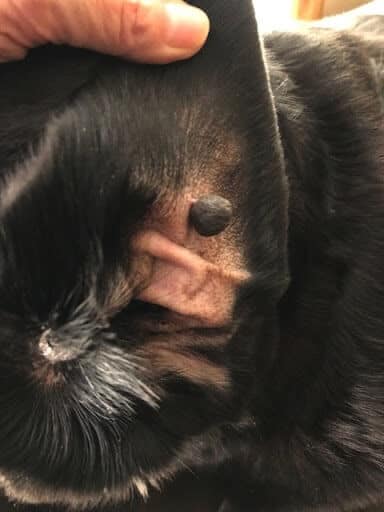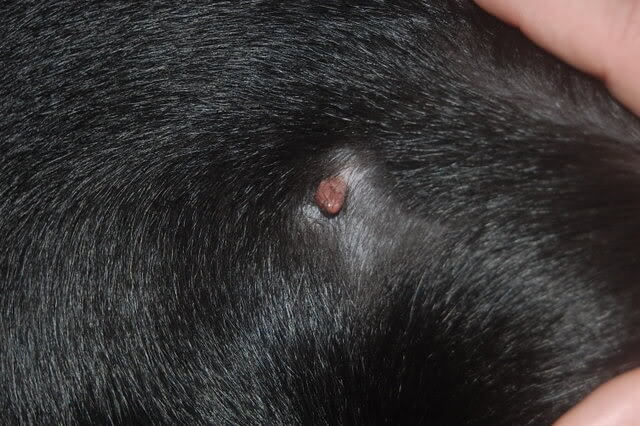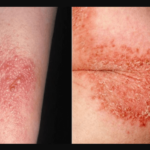Perhaps you have seen several skin tags on your dog? Perhaps you are concerned that the skin tag on your dog is dangerous? In this article, I will describe what are dog skin tags, how to remove dog skin tags, and the cost to remove the dog skin tags.
Dog skin tags are, like human skin tags, a growth of soft, hanging skin. Skin tags on dogs are also called dog warts, acrochordons, or skin polyps. Although they can be classified as tumors, there’s no need to be afraid of them because they are benign.
Skin tags can be found on all dog breeds; however, they are more commonly found on some breeds than others. Skin tags can be located anywhere on a dog’s body. Most often, they only measure about several millimeters in size.
Vets can remove dog skin tags in many ways. The ways dog skin tags can be removed, along with the estimated cost, are as follows:
- Cryosurgery (approximately $125)
- Cauterization (approximately $175)
- Ligation (approximately $75)
- Surgery (approximately $800)
In addition to the surgery cost, there is often a biopsy procedure that typically costs around $150.
Some dog breeds have higher chances of developing skin tags due to environmental factors. Read on to learn more about skin tags on dogs, including dog skin tag pictures, dog skin tag removal, as well as the cost to remove skin tags on dogs.
What Are Dog Skin Tags?
Dog skin tags are fibrous tissues that are classified as fibromas. The term “skin tag” was used to define them because they appear to be just like tags. These fibrous tissues form elongated stalks on the skin that look similar to warts.
These skin tags are not really warts but are growths of collagen, as well as other fibrous tissues that are part of a dog’s body. While they cannot spread, they can grow in several places and can develop anywhere in the body.
Some people confuse dog skin tags with ticks, especially if they are small. To be sure, carefully check the “ticks” before attempting to remove them. There are different kinds of skin tags, but the most common types usually develop in older dogs. However, younger dogs can also develop skin tags if the conditions are right. No dog breeds are immune to skin tags.
Dog Skin Tag Pictures
To correctly diagnose whether the growth on your dog is a skin tag or not, it helps to look at dog skin tag pictures.





After seeing the above pictures of skin tags on dogs, you are still uncertain if the growth is a skin tag, then see a vet.
What Can Cause Dog Skin Tags?
There are many reasons why skin tags develop in a dog. Here are some of the causes of dog skin tags:
1. Parasites
Parasites are small pests that love to attach themselves to dogs and other pets to feed on blood. Examples of these parasites are lice, mites, ticks, and fleas. These pests can infest the skin of your dog cause your dog’s skin to itch.
Dogs will try to get rid of the itch by scratching their skin. If the itching is not addressed at once, it may cause skin damage. That part of the skin will be inflamed and then infected. Soon, skin tags could develop after treating the itch.
2. Too Tight Collars
If your dog’s collar is too tight, his skin will be irritated. The skin will break open if the situation persists and leads to skin damage, including the development of skin tags. This is a common cause for a skin tag on dog or cat.
3. Genetics
If the breed line of your dog is prone to skin tags, then your dog will most likely develop them. Some dogs may also inherit skin tags from their parents.
4. Food
A poor diet can cause skin tags to develop in dogs. Without proper nutrition, your dog may develop health problems, including skin conditions such as skin tags. Poor nutrition tends to weaken your dog’s immune system. Aside from skin tags, your dog may also develop skin rashes and cracks in his skin.
5. Hygiene
Bathing should be a routine for your dog. It is not necessary to bathe your dog every day. However, he should be washed at least once a month to eliminate parasites and irritants from attaching to his skin. Also, don’t overdo it because you may strip your dog’s skin of the important oils it needs.
6. Environment
There are substances in your environment that are harmful to your dog’s skin. Elements such as hazardous chemicals, pesticides, and pollution can come into contact with your dog’s skin and cause skin tags to develop.
Symptoms of Dog Skin Tags
Dog skin tags need time to develop and become noticeable. So, you will first notice telltale signs before you see them on your dog’s skin. Some of the common symptoms that you need to be watchful of include:
- A skin growth that appears flat at the start
- A skin growth that looks like a stalk
- Skin growth with hair follicles
- Wart-like skin growth
These skin growths tend to vary in size and appearance. If they increase in size, they will cause distress to your dog.
How to Confirm If Your Dog Has Skin Tags
If you want to confirm if your dog has skin tags, you need to bring them to a veterinarian. The vet will likely recommend a biopsy of the skin tag. The vet will get a sample of the skin growth using a thin needle. This is the same procedure for a skin tag on dog or cat.
A biopsy is done to confirm whether the growth is malignant or benign. When the vet has obtained the results, he will be able to recommend the best way to treat the problem.
In confirming if it’s a skin tag or not, you need to observe the size, appearance, and location of the skin tag. You can track its progress by taking pictures of it from the first time that you have observed it up to the time that it grows in size. Also, dog skin tag bleeding is a common occurrence. If there is bleeding from the dog’s skin tag, then it should be removed.
Your vet may also advise you to observe if there are any changes in your dog’s weight and appetite, including other unusual symptoms, such as vomiting or diarrhea.
How to Remove Skin Tags on Dogs

So now that you are certain that your dog has a skin tag, let’s look at how to remove skin tags on dogs. Vets can remove dog skin tags in several ways. Here are some of the methods:
1. Surgery
There are cases when a surgical procedure is required for the removal of your dog’s skin tags. Moreover, if the vet thinks that they need more information about the skin tag’s growth, they may cut off a portion of it and send it to the lab for biopsy.
2. Cryosurgery
In this method, your dog’s skin tag will be frozen using liquid nitrogen. This process is advantageous to your dog because it is quick and painless.
3. Cauterization
In this method, your dog’s skin tag is burned with a laser-like pen. After burning, the skin tag will fall off instantly. This procedure is more invasive than cryosurgery. The vet will inject local anesthesia into your dog so that it won’t feel the heat of the burning laser. A dog skin tag will stand no chance against a laser and will fall off with ease.
4. Ligation
This method is the least invasive procedure of all. When the vet has located the skin tag, they will tie it off with a small piece of thin string. The vet can easily do this procedure with a skin tag that has a large base since they can quickly wrap the string on a bigger area.
The procedure will be more difficult if the skin tag has a smaller base. When the skin tag is tied off, it will no longer receive the oxygen and blood that it needs for it to grow. After a couple of days, the dog’s skin tag will begin to shrink. Its fleshly color will often turn into grayish or blackish color before it falls off.
Dog Skin Tag Removal Cost
We’ve looked at how to remove a dog skin tag; now, let’s look at dog skin tag removal cost. While most skin tags on dogs are usually harmless, in some cases, you still need to have them removed by a vet. Consulting a vet is still the best option if you want your dog to live a happy and healthy life.
The actual cost of removal will depend on several factors. It may include the cost of a biopsy if the vet wants to be sure whether the skin tag is benign or malignant. Other factors include the type of procedure, the number of skin tags to be removed, and their particular locations.
If the skin tag does not irritate your dog, the vet will likely advise just to leave it. Dog skin tag bleeding is a common side effect. If the skin tag is bleeding, then it should be removed. Any procedures listed above may be recommended if the skin tag is growing or when an infection develops. The average cost for each procedure is as follows:
- Biopsy – One of the extra expenses that you need to anticipate is the cost of biopsy. This process will be required if you really want to make sure that the skin tag of your dog is not cancerous. A biopsy procedure typically costs around $150. This additional cost will incur on top of the medical procedure of removing the skin tag.
- Surgery – Depending on the size and number of skin tags, including anesthesia, the average cost could be around $800 or more.
- Cryosurgery – The cost is approximately $125.
- Cauterization – The cost is around $175.
- Ligation – The cost is about $75.
Can You Remove Dog Skin Tags at Home?
If you want to save money, you might be tempted to remove your dog’s skin tag yourself. However, it is wiser to think about the consequences before doing it all by yourself.
If you cut open your dog’s skin to remove his skin tag, your dog becomes more prone to developing an infection. Moreover, if you do it without using anesthesia, you will inflict excruciating pain on your dog.
You should understand that not all dog skin tags are the same. Additionally, not every skin growth on your dog qualifies as a skin tag. Not going to the vet to determine if it is benign or malignant will put your dog at unnecessary health risks. You won’t be able to know if the growth is cancerous or not.
If you really love your dog, it is better to be on the safe side. Yes, you can remove the skin tag yourself. But since you don’t have any medical training and you are not medically authorized to do it, you are putting up your dog to unnecessary risks. If you want to remove your dog’s skin tags, it is better to consult with a vet.
How to Prevent Dog Skin Tags

Preventing the growth of skin tags is better and cheaper than getting them removed. Here are some practical ways to avoid the development of skin tags on your dog:
1. Prevent Parasite Infestation
Always check your pet for mites, ticks, and fleas. Parasite infestation will increase the chances of skin tag developing on the skin of your dog. Prevent parasite infestation by:
- Visiting the vet regularly for parasite checkup
- Washing your hands after soil exposure
- Keeping lawn grass short
- Frequently cleaning your dog’s bed
- Giving parasite prevention medication every month
2. Provide a Nutritious and Balanced Diet
A healthy dog will be able to ward off any kind of disease if you feed him a balanced and nutritious diet. If your dog has skin issues, ask the vet regarding the types of food your dog should eat and the kinds of food that your furry pal needs to avoid.
3. Take Care of Your Dog’s Skin
You should regularly bathe your canine companion for at least once a month. Regular bathing will allow his skin to create natural oils that help in maintaining the health of his skin and coat.
4. Breeding
Choose dog breeds that are not prone to skin tags. If you don’t want dog skin tags to be a problem, stay away from terriers, cocker spaniels, schnauzers, and poodles. If you still want to own any of these breeds, then take good care of their health to prevent them from getting skin tags.
Conclusion – Skin Tags on Dogs
Dog skin tags are sometimes called dog warts, acrochordons, or skin polyps. While they can be considered as tumors, there is no need to be alarmed since most of them are benign.
Specific breeds of dogs tend to be more susceptible to skin tag development. However, other dog breeds can also develop it. These skin tags can occur anywhere on a dog’s body. They can be safely removed, but only by a vet.



![Golden Brown Skin Tone - What Is It? [With Pictures] golden brown skin](https://skincaregeeks.com/wp-content/uploads/2021/04/golden-brown-skin-150x150.jpg)
![Neutral Skin Tone Defined [and Best Colors for Neutral Skin] neutral skin tone](https://skincaregeeks.com/wp-content/uploads/2021/05/neutral-skin-tone-150x150.png)




